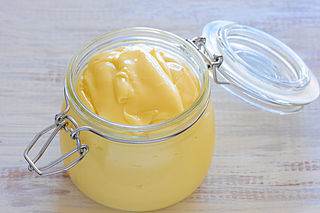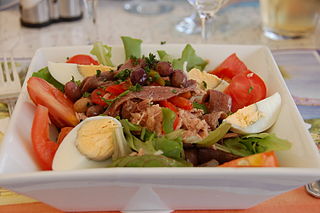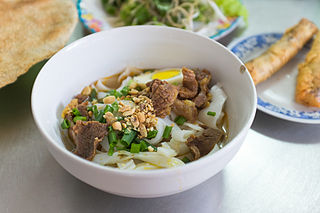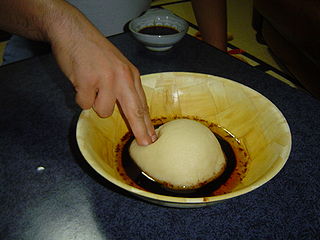The examples and perspective in this article may not represent a worldwide view of the subject.(April 2020) |

A salad bowl is a bowl-shaped serving dish used to serve salads, especially tossed salads.
The examples and perspective in this article may not represent a worldwide view of the subject.(April 2020) |

A salad bowl is a bowl-shaped serving dish used to serve salads, especially tossed salads.
Salad bowls may be made of any of the usual materials used for tableware, including ceramics, metal, plastic, glass, or wood. Salad bowls can also be made from renewable materials such as Poly-lactic Acid (PLA), wheat straw fiber and sugarcane bagasse. [1]
In the United States from the 1940s to the 1960s, wooden salad bowls were recommended by many cookbooks. This fashion was started by the restaurateur and food writer George Rector, who in 1936 wrote a column entitled "Salad Daze". In that column, he recommended using an unvarnished wooden salad bowl, purportedly a French tradition. He recommended rubbing garlic into it for a hint of garlic flavor, oiling it regularly, and never washing it: [2]
...age has everything to do with the bowl.... Wood, you see, is absorbent, and after you’ve been rubbing your bowl with garlic and anointing it with oil for some years, it will have acquired the patina of a Corinthian bronze and the personality of a 100-year-old brandy.
...Thirty years of sheer joy have oiled and polished and savored it until it is as distinguished an object as a 2,000-year-old Chinese shrine made of sandalwood.
By that Christmas season, wooden salad bowls had become a fashionable gift item, [2] and by 1949, the cultural critic Russell Lynes was saying that a highbrow person "wouldn't dream of washing his salad bowl". [4]
The wooden salad bowl was criticized soon thereafter, even if it had a finish:
The finish on cheap and badly made bowls will soon crack, the oil will seep into the crevices and eventually go rancid, and if garlic is rubbed frequently over the surface, the desirable faint undertone will soon become an objectionable odor that can only be described as a stench.
— Louis P. DeGouy (1945), "The Mixing of the Green" [5]
Large wooden salad bowls, we are so often and authoritatively told, become seasoned with constant use, particularly if they are never washed. But it must be pointed out that the bowl, sooner or later, will develop imperceptible cracks, oil and food particles will inevitably collect in the cracks and become rancid.
Rubbing garlic on the salad bowl has a long history:
...frott[er] le saladier avec de l'ail qu'on écrase avec une croûte de pain nommée Chapon.
rub the salad bowl with garlic crushed with a crust of bread called a "capon"— J. B. B. de Roquefort (1815) [7] , Histoire de la vie privée des françois
Even in the United States, this predates Rector: an American salad cookbook from 1926 recommends it in many recipes. [8]
Salad bowls may be of any shape and size, from very flat to very tall.

Garlic is a species of bulbous flowering plant in the genus Allium. Its close relatives include the onion, shallot, leek, chive, Welsh onion, and Chinese onion. It is native to Central Asia, South Asia and northeastern Iran and has long been used as a seasoning worldwide, with a history of several thousand years of human consumption and use. It was known to ancient Egyptians and has been used as both a food flavoring and a traditional medicine. China produced 73% of the world's supply of garlic in 2021.

Mayonnaise, colloquially referred to as "mayo", is a thick, cold, and creamy sauce commonly used on sandwiches, hamburgers, composed salads, and French fries. It also forms the base for various other sauces, such as tartar sauce, fry sauce, remoulade, salsa golf, ranch dressing, and rouille.

Tzatziki, also known as cacık or tarator, is a class of dip, soup, or sauce found in the cuisines of Southeastern Europe and West Asia. It is made of salted strained yogurt or diluted yogurt mixed with cucumbers, garlic, salt, olive oil, red wine vinegar, sometimes with lemon juice, and herbs such as dill, mint, parsley and thyme. It is served as a cold appetiser (meze), a side dish, and as a sauce for souvlaki and gyros sandwiches and other foods.

Pesto or more fully pesto alla genovese is a paste made of crushed garlic, pine nuts, salt, basil leaves, grated cheese such as Parmesan or pecorino sardo, and olive oil. It originated in the Italian city of Genoa, and is used to dress pasta and flavour genoese minestrone soup.

Puerto Rican cuisine consists of the cooking style and traditional dishes original to Puerto Rico. It has been primarily a fusion influenced by the ancestors of the Puerto Rican people: the indigenous Taínos, Spanish Criollos and sub-Saharan African slaves. As a territory of the United States, the culinary scene of Puerto Rico has also been moderately influenced by American cuisine.

A cutting board is a durable board on which to place material for cutting. The kitchen cutting board is commonly used in preparing food; other types exist for cutting raw materials such as leather or plastic. Kitchen cutting boards are often made of wood or plastic and come in various widths and sizes. There are also cutting boards made of glass, steel, or marble, which are easier to clean than wooden or plastic ones such as nylon or corian, but tend to damage knives due to their hardness. Rough cutting edges—such as serrated knives—abrade and damage a cutting surface more rapidly than do smooth cutting implements.

Iraqi cuisine is a Middle Eastern cuisine that has its origins in the ancient Near East culture of the fertile crescent. Tablets found in ancient ruins in Iraq show recipes prepared in the temples during religious festivals—the first cookbooks in the world. Ancient Mesopotamia was home to a sophisticated and highly advanced civilization, in all fields of knowledge, including the culinary arts.

Cypriot cuisine is the cuisine of the island of Cyprus, shared by both Greek Cypriots and Turkish Cypriots.

Garlic bread consists of bread, topped with garlic and occasionally olive oil or butter and may include additional herbs, such as oregano or chives. It is then either grilled until toasted or baked in a conventional or bread oven.

Salade niçoise is a salad that originated in the French city of Nice. It is traditionally made of tomatoes, hard-boiled eggs, Niçoise olives and anchovies or tuna, dressed with olive oil, or in some historical versions, a vinaigrette. It has been popular worldwide since the early 20th century, and has been prepared and discussed by many chefs. Delia Smith called it "one of the best combinations of salad ingredients ever invented" and Gordon Ramsay said that "it must be the finest summer salad of all".

Mì Quảng, literally "Quảng noodles", is a Vietnamese noodle dish that originated in Quảng Nam Province in central Vietnam. It is one of the region's most popular and well-recognized food items, and is served on various occasions, such as at family parties, death anniversaries, and Tết. It is a common food item in Ðà Nẵng and the surrounding region, where it is eaten at any time of day.

Lawry's is an upscale gourmet restaurant chain specializing in prime rib and the brand name of a seasoned salt blend spun off by the restaurant founders that evolved into a food products company today owned by McCormick & Company.

The pan bagnat is a sandwich that is a specialty of Nice, France. The sandwich is composed of pain de campagne, a whole wheat bread, enclosing a salade niçoise, a salad composed mainly of raw vegetables, hard boiled eggs, anchovies and/or tuna, and olive oil, salt, and pepper. Sometimes vinegar is added, but never mayonnaise. It was historically prepared to use day-old bread.

Asida is a common dish in the Arab world. It is a lump of dough, obtained by stirring wheat flour into boiling water, sometimes with added butter or honey. Similar in texture to fufu, it is eaten mainly in Middle East and African countries. It is considered one of the most popular desserts and traditional dishes in many Arab countries.

Many cuisines feature eggplant salads and appetizers.

Harissa is a hot chili pepper paste, native to the Maghreb. The main ingredients are roasted red peppers, Baklouti peppers (بقلوطي), spices and herbs such as garlic paste, caraway seeds, coriander seeds, cumin and olive oil to carry the oil-soluble flavors.

People of some cultures eat octopus. The arms and sometimes other body parts are prepared in various ways, often varying by species and/or geography.

Andrea Jourdan is a Canadian chef, ghost writer and a culinary author with over 100 published cookbooks.